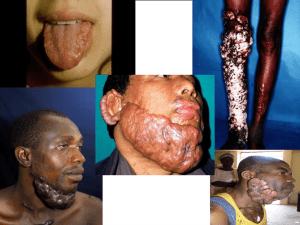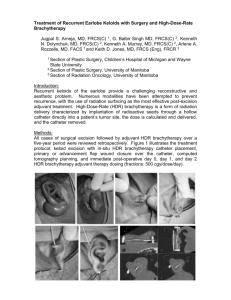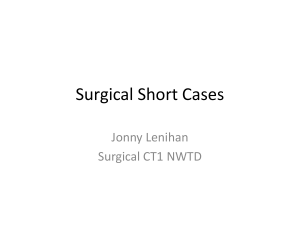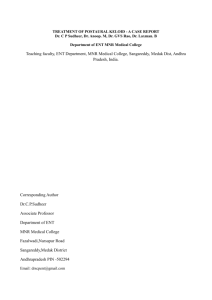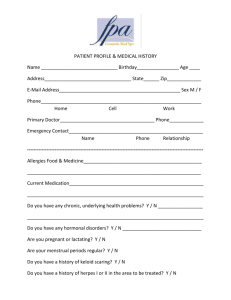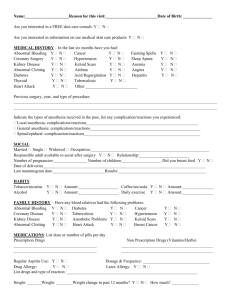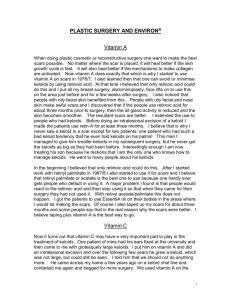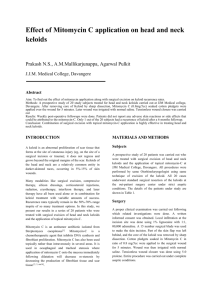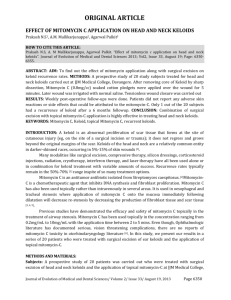Document 13310523
advertisement
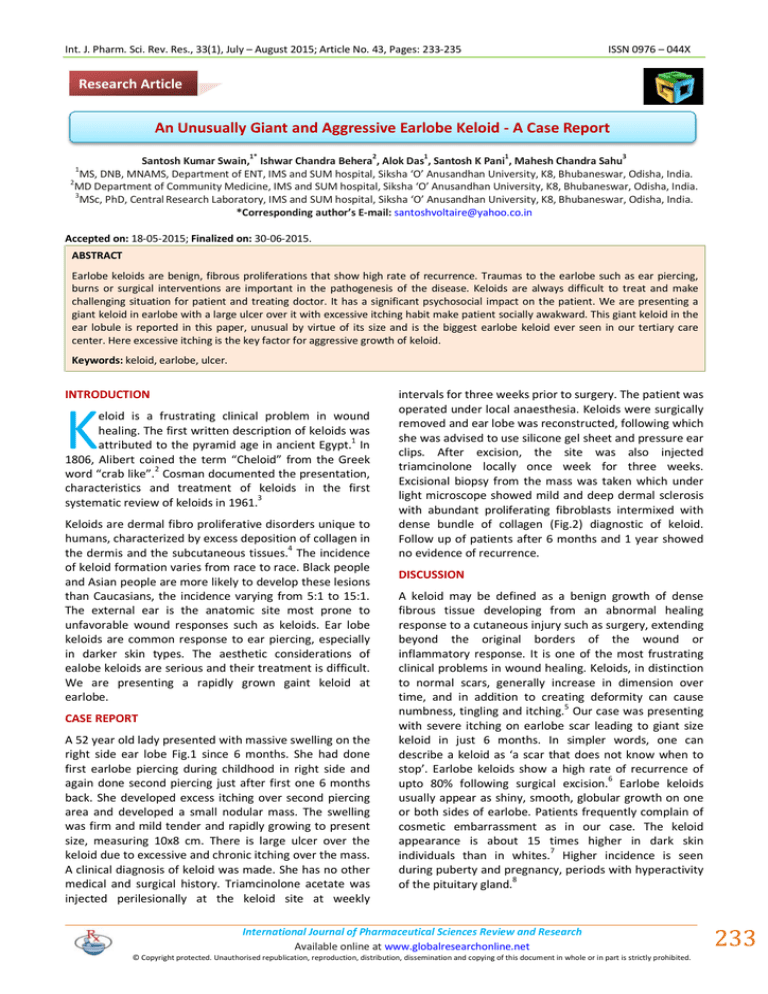
Int. J. Pharm. Sci. Rev. Res., 33(1), July – August 2015; Article No. 43, Pages: 233-235 ISSN 0976 – 044X Research Article An Unusually Giant and Aggressive Earlobe Keloid - A Case Report 1* 2 1 1 3 Santosh Kumar Swain, Ishwar Chandra Behera , Alok Das , Santosh K Pani , Mahesh Chandra Sahu MS, DNB, MNAMS, Department of ENT, IMS and SUM hospital, Siksha ‘O’ Anusandhan University, K8, Bhubaneswar, Odisha, India. 2 MD Department of Community Medicine, IMS and SUM hospital, Siksha ‘O’ Anusandhan University, K8, Bhubaneswar, Odisha, India. 3 MSc, PhD, Central Research Laboratory, IMS and SUM hospital, Siksha ‘O’ Anusandhan University, K8, Bhubaneswar, Odisha, India. *Corresponding author’s E-mail: santoshvoltaire@yahoo.co.in 1 Accepted on: 18-05-2015; Finalized on: 30-06-2015. ABSTRACT Earlobe keloids are benign, fibrous proliferations that show high rate of recurrence. Traumas to the earlobe such as ear piercing, burns or surgical interventions are important in the pathogenesis of the disease. Keloids are always difficult to treat and make challenging situation for patient and treating doctor. It has a significant psychosocial impact on the patient. We are presenting a giant keloid in earlobe with a large ulcer over it with excessive itching habit make patient socially awakward. This giant keloid in the ear lobule is reported in this paper, unusual by virtue of its size and is the biggest earlobe keloid ever seen in our tertiary care center. Here excessive itching is the key factor for aggressive growth of keloid. Keywords: keloid, earlobe, ulcer. INTRODUCTION K eloid is a frustrating clinical problem in wound healing. The first written description of keloids was attributed to the pyramid age in ancient Egypt.1 In 1806, Alibert coined the term “Cheloid” from the Greek word “crab like”.2 Cosman documented the presentation, characteristics and treatment of keloids in the first systematic review of keloids in 1961.3 Keloids are dermal fibro proliferative disorders unique to humans, characterized by excess deposition of collagen in the dermis and the subcutaneous tissues.4 The incidence of keloid formation varies from race to race. Black people and Asian people are more likely to develop these lesions than Caucasians, the incidence varying from 5:1 to 15:1. The external ear is the anatomic site most prone to unfavorable wound responses such as keloids. Ear lobe keloids are common response to ear piercing, especially in darker skin types. The aesthetic considerations of ealobe keloids are serious and their treatment is difficult. We are presenting a rapidly grown gaint keloid at earlobe. CASE REPORT A 52 year old lady presented with massive swelling on the right side ear lobe Fig.1 since 6 months. She had done first earlobe piercing during childhood in right side and again done second piercing just after first one 6 months back. She developed excess itching over second piercing area and developed a small nodular mass. The swelling was firm and mild tender and rapidly growing to present size, measuring 10x8 cm. There is large ulcer over the keloid due to excessive and chronic itching over the mass. A clinical diagnosis of keloid was made. She has no other medical and surgical history. Triamcinolone acetate was injected perilesionally at the keloid site at weekly intervals for three weeks prior to surgery. The patient was operated under local anaesthesia. Keloids were surgically removed and ear lobe was reconstructed, following which she was advised to use silicone gel sheet and pressure ear clips. After excision, the site was also injected triamcinolone locally once week for three weeks. Excisional biopsy from the mass was taken which under light microscope showed mild and deep dermal sclerosis with abundant proliferating fibroblasts intermixed with dense bundle of collagen (Fig.2) diagnostic of keloid. Follow up of patients after 6 months and 1 year showed no evidence of recurrence. DISCUSSION A keloid may be defined as a benign growth of dense fibrous tissue developing from an abnormal healing response to a cutaneous injury such as surgery, extending beyond the original borders of the wound or inflammatory response. It is one of the most frustrating clinical problems in wound healing. Keloids, in distinction to normal scars, generally increase in dimension over time, and in addition to creating deformity can cause numbness, tingling and itching.5 Our case was presenting with severe itching on earlobe scar leading to giant size keloid in just 6 months. In simpler words, one can describe a keloid as ‘a scar that does not know when to stop’. Earlobe keloids show a high rate of recurrence of upto 80% following surgical excision.6 Earlobe keloids usually appear as shiny, smooth, globular growth on one or both sides of earlobe. Patients frequently complain of cosmetic embarrassment as in our case. The keloid appearance is about 15 times higher in dark skin individuals than in whites.7 Higher incidence is seen during puberty and pregnancy, periods with hyperactivity of the pituitary gland.8 International Journal of Pharmaceutical Sciences Review and Research Available online at www.globalresearchonline.net © Copyright protected. Unauthorised republication, reproduction, distribution, dissemination and copying of this document in whole or in part is strictly prohibited. 233 © Copyright pro Int. J. Pharm. Sci. Rev. Res., 33(1), July – August 2015; Article No. 43, Pages: 233-235 ISSN 0976 – 044X of transforming growth factor beta (TGF-ß) in cutaneous scarring as well as scarring in other body parts.12 Although TGF-ß is needed for wound healing, overproduction of it can result in excessive deposition of scar tissue and fibrosis. Aberrations in the different cytokines like interleukins 6, 13 and 15 may also have role in keloid formation.13 Keloid scars are nodular skin lesion that in severe form resemble neoplasms and cause much physical and mental distress. Attempts for treatment may make them worse and presently there is also no single therapeutic modality is available. The location, size, depth and duration of the earlobe keloid influence the choice of therapy. Excision can also be used for large keloids, for debulking or removal of infected regions.14 Surgical excision alone leads to high chance of recurrence rate, 15 between 50-100%. Figure 1: Right side earlobe showing a giant keloid with an ulcer over the surface. Therefore it is rarely used as monotherapy and so postoperative recurrence can be reduced by adjunctive therapies such as intralesional corticosteroid injections, radiotherapy, pressure therapy and immuno modulators. CONCLUSION The etiopathogenesis of keloid remains an enigma and is characterized by excessive deposition of collagen in the dermis and subcutaneous tissues secondary to traumatic or surgical injuries. The large size and rapid growth with excessive itching are unique presentation of this keloid and has significant psychosocial impact for the patient. This is the biggest earlobe keloid seen in our center. Here excessive itching is the key factor for aggressive growth of keloid. Acknowledgement: Authors are thankful to Prof Manoj Ranjan Nayak, Founder president of SOA University, Bhubaneswar, Odisha, India for his active encouragement in research. Figure 2: Microphotograph showing keloidal collagen with abundant fibroblasts. Although there are many theories about keloid formation, their etiology is still unknown. Osman claim that an autoimmune response to sebum trapped deep in dermis may lead to keloid formation.9 A disorder of the hormone that stimulates melanocyte is one of the factors that is accused of causing keloid formation. In a recent study it is reported that cycloxygenase (COX 2) enzyme gene expression is absent in abnormal scar derived fibrioblasts and may contribute to the development of fibrotic scars, and that COX gene expression could be modulated by hexose sugars and sucrose, especially in normal granulation tissue fibroblasts (about 90% decrease at maximum) and hypertrophic scar fibroblasts (almost seven folds increase).10 It has also been shown recently that sucrose type 1 and type 3 collagen metabolism in granulation tissue fibroblast cultures, but it regulates type 1 and type 3 collagen metabolism in fibroblast cultures derived from fibrotic skin lesions differently, changing the collagen metabolism toward 11 normal. Experimental study implicates the importance REFERENCES 1. Breasted JH, The Edwin Smith Surgical papyrus, Vol.1. hiero-glyphic translation and commentary, Chicago University of Chicago press, 1930, 403-406. 2. Alibert JLM, Description des maladies de la Peau observes a hospital saint-Louis et exposition des meilleures methods suives pour leur traitment. Barrois l’aine et files, 113, 1806. 3. Shockman S, Paghdal KV, Cohen G, Medical and surgical management of keloids: a review, J Drugs Dermatol, 9(10), 2010, 1249-1257. 4. Meenakshi J, Jayaraman V, Ramakrishnan KM, Babu M. Keloids and hypertrophic scars: a review, Indian J Plast Surg, 38, 2005, 175-179. 5. De Felice B, Wilson RR, Nacca M, Telomere shortening may be associated with human keloids, BMC Med Jenet, 28, 2009, 10-11. 6. Mall JW, Pallmann C, Muller JM, Buttemyer R. Keloid of the earlobe after ear piercing. Not a surgical problem. Chirurg, 73(5), 2002, 514-516. International Journal of Pharmaceutical Sciences Review and Research Available online at www.globalresearchonline.net © Copyright protected. Unauthorised republication, reproduction, distribution, dissemination and copying of this document in whole or in part is strictly prohibited. 234 © Copyright pro Int. J. Pharm. Sci. Rev. Res., 33(1), July – August 2015; Article No. 43, Pages: 233-235 7. Moshref SS, Mufti ST. Keloid and hypertrophic Scars: Comparative Histopathological and Immunohistochemical Study, Med Sci, 17, 2010, 3-22. 8. Akoz T, Gideroglu K, Akan M, Combination of different techniques for the treatment of earlobe keloids. Asthetic plast Surg, 26(3), 2002, 184-188. 9. Hunasgi S, Koneru A, Vanishree M, Shamala R, Keloid: A case report and review of pathophysiology and differences between keloid and hypertrophic scars, J oral maxillofacial pathol, 17(1), 2013, 116-120. 10. Koonin AJ, The etiology of keloids: a review of the literature a new hypothesis, S Afr Med J, 38, 1964, 1913. 11. Kossi J, Peltonen J, Uotila P, Laato M. Differential effects of hexose and sucrose, and platelet derived growth factor isoforms or cyclooxygenase-1 and 2 m RNA expression in ISSN 0976 – 044X keloid, hypertrophic scar and granulation tissue fibroblasts. Arch Dermatol Res, 293, 2001, 126. 12. Blobe GC, Schiemann WP, Lodish HF. Role of transforming growth factor beta in human disease. N Engl J Med, 342, 2000, 1350-1358. 13. Alster TS, Tanzi EL, Hypertrophic scars and keloids: Aetiology and management. Am J Clin Dermatol, 4, 2003, 235-243. 14. Ogawa R. The most current algorithms for the treatment and prevention of hypertrophic scars and keloids, Plast Reconstr Surg, 125(2), 2010, 557-568. 15. Nast A, Eming S, Fluhr J, Fritz K, Gauglitz G, Hohenleutner S, Panizzon RG, Sebastian G, Sporbeck B, Koller J, German S2k guidelines for the therapy of pathological scars (hypertrophic scars and keloids), J Dtsch Dermatol Ges, 10(10), 2012, 747-762. Source of Support: Nil, Conflict of Interest: None. International Journal of Pharmaceutical Sciences Review and Research Available online at www.globalresearchonline.net © Copyright protected. Unauthorised republication, reproduction, distribution, dissemination and copying of this document in whole or in part is strictly prohibited. 235 © Copyright pro
